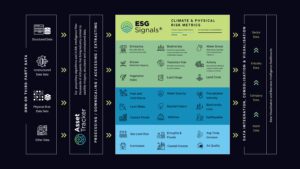When it comes to financial reporting, companies understand the need to report verifiable data. Yet, when it comes to numbers, associated with environmental aspects, that element of objectivity is starkly missing. This is evident in how many corporates report greenhouse gas (GHG) emissions, water usage, or the types of chronic climate risks that their physical assets are prone to, like heat waves or hurricanes to name a few. Most often, these numbers are not mentioned or, at best, they are reported as an aggregate. A verifiable way to address this is through the use of environmental, climate, and physical risk (ECP) data at an asset level. In this context, asset refers not to financial assets but to the company’s physical assets like factories, storage facilities, headquarters, etc. These assets often face different issues and opportunities depending on the region they are situated in and the role they play within the company. While verifiable aggregates may be acceptable for company reporting, the lack of detailed asset-level metrics and tracking make it impossible to quantify financial impact for prudent budgeting and risk mitigation by the CFO’s organization.
When looking at companies’ reports of environmental performance, there is a difference in what is expected and measured depending on the sphere they are part of. On the one hand, companies in traditionally polluting sectors like oil and gas or metals and mining are under constant scrutiny about the influence they have on their surrounding environment. Their assets should be assessed regularly to ensure they are being managed prudently with attention to sensitive data. On the other hand, we have companies in sectors that are conventionally seen as more sustainability-conscious, such as electric vehicle (EV) production, which can also have a significant environmental footprint that should be monitored. While not immediately associated with pollution, these companies may actually have a significant environmental footprint through the burdens of their supply chain or the way they manage their physical locations such as offices, storage facilities, etc.
A company in the utilities sector for example, can have several individual assets that contribute significantly to the carbon emissions or be prone to several environmental or physical risks. Perhaps it is because its building is outdated and it has not been reconstructed to adhere to new building regulations or ensure a low emissions footprint. Or it happens to be in an area that has water stress and its functions are adding an additional strain to the resource. In addition to being a source of environmental pollution, these assets are also points of large financial and operational risk to the organization. Making these assets efficient will require companies to collect and understand asset-level operational metrics and benchmark those numbers with other similar assets that belong to the company and its peers. It is equally important to understand the risks associated with the physical environment in which these assets are operating.
The footprint of a company also does not have to come from its own assets. Sometimes a company can make every effort to update facilities to produce less emissions and build new ones only in areas with low influence on the surrounding nature, and still contribute to pollution. The reason for this can be an unsustainable supply chain. For example, a typical company in the EV production industry, which is usually regarded as a sustainable one because it is an alternative to the traditionally polluting automobile industry, may contribute negatively to the environment through some of the materials that are necessary for the construction of the products. For example, the sourcing of raw materials that are key for the production of vehicles such as lithium can cause soil and air quality damage (Source).
It is important to think of the types of metrics that are relevant for each asset. While most investors may immediately think about emissions or water stress, for example, there are many other metrics that should be considered. Those include environmental risk metrics like land usage, land cover, proximity to biodiversity hotspots, etc., chronic climate and physical risk metrics such as precipitation intensity or wildfire risk, and even acute climate and physical risk metrics like sea level rise or flood risks. It is important to consider which type of metrics are particularly relevant to each asset of the company, depending on its location. New ECP (Environmental, Climate and Physical) risk assessment methods allow exactly this. They enable investors to select metrics depending on the specific features of the geographical region it is situated within, allowing for better analysis and prediction of real performance.
A sector where this is immediately relevant is insurance. ECP data on an asset level can reveal a lot about the risks that companies should be insuring assets for, depending on their surrounding environment. One example of this can be seen in the damages caused by California wildfires. If insurance companies used the physical risk metrics that companies like RS Metrics offered, it would have been easier to predict the damages and better understand how the assets should have been insured. For example, a use case from RS Metrics from 2018 shows how satellite imagery can be used to assess the damage caused by the Camp Fire in California (Source).
The company created a database that provided information about small sections of the land and how they have changed after the start and the containment of the fire, which allowed people to measure the effect of the fire on properties. The information was then used to map out which properties required restoration as well as other statistical data to help better understand the influence of the fire on the environment in the area and the financial costs associated with it.
While the operational inefficiencies of an asset can cause reduced return in capital invested, operational failure due to environmental risks can cause huge losses to the company. These risks could come as a result of specific weather events, like a wildfire or earthquake, or due to gradual environmental changes over time like coastal erosion or average temperature increase.
A key solution to mitigating these risks can come from collecting detailed asset-level data in real time and being proactive about managing these risks. RS Metrics provides analysis-ready for environmental, climate, and physical risk themes. To do this, its two main products, ESGSignals® and AssetTracker, use machine learning and AI to be able to extract valuable insights about companies’ performance and opportunities. This solution is also available as a SaaS through Google Cloud Marketplace for customers of different sizes and industries (explore ESGSignals® on Google Cloud Marketplace here).

An overview of climate and physical risk metrics that might be important to consider depending on the specific location that is being assessed.
Prudent risk mitigation approaches require a detailed understanding of each asset’s footprint, the environment it is operating in, and reliable predictions of the changes occurring around it. Corporate Boards and the executive teams will be well-served to understand these details while reassuring risk councils and investors about the security of their financial investments and business continuity of their operations. While it is easy to make decisions about a company at a broad level based on financial metrics, CFOs should actually look at granular ECP data to reveal a more accurate depiction of the company’s performance. That will allow for more strategic and confident investments.
A report from S&P global states that 66% of major global companies have at least one asset at high risk of physical risk under the high impact climate change scenario in 2050. Robert Herz, Member of the Board of Directors of Morgan Stanley and Former Chair of the Financial Accounting Standards Board explains, “Properly monitoring, managing, and reporting progress against targets and commitments requires accurate, timely, and reliable data on the performance of a company’s principal assets and operations on these environmental dimensions. And so as with financial data, this data on corporate environmental performance will increasingly be communicated to stakeholders and the market directly by companies and through data aggregators. “What about the company you work for or last invested in? Tools like ESGSignals® and AssetTracker can allow for checking that and comparing how a company is doing compared to other leaders in its industry. While not only useful for investing, these tools can help companies better understand the sustainability performance of their assets and prevent further pollution or damages through the power of real-time assessment on an asset level.
Zoom of Parcels with Pre-Event Imagery and Example Attributes

Tan is an advisor on the board of RS Metrics. He is a strategy consultant on workforce transformation and sustainable development. He led a UN workgroup to define metrics for corporates to impact the Sustainable Development Goals (SDGs). He recently retired from Infosys as an Executive Vice President.
















